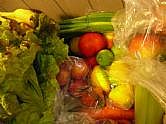How to guide for Harvesting Vegetables
By GreenGardenChic
eHow Community Member
Summer is in full bloom and the vegetable garden is starting to feel like a chore? Here are some simple tips for how to harvest some of late summers most popular crops and when veggies should be picked for the best flavor.
Instructions
-
Step 1
Broccoli and Cauliflower: Harvest early in the morning while the sugars are high in the stems and florets. Cut the stalks before they flower or turn yellow (flowers = bitter taste). Leave 5 inches of the stems in-tact to produce more side shoots for a later harvest.
-
Step 2
 when to pick corn
when to pick cornCorn: Takes about 20 days to mature after the silks first start to emerge. Wait for the silks to turn dark and start to shrivel. Peel back the leaves to expose a few kernels, when you bust a kernel with your fingernail, the kernel should be full of "milky" juice. Cook immediately, corn doesn’t store well.
-
Step 3
Cucumbers: Harvest when small, firm, and dark green for the best flavor. Pickle size should be 2 inches for sweets, 4-6 inches for dill pickles, and 6-8 inches for slicing.
-
Step 4
 Ripe veggies
Ripe veggiesEggplant: Fruits should be an average size of 6-8 inches. Eggplants should be firm and glossy when they're ready for harvest.
-
Step 5
Garlic: Harvest when the tops turn yellow/brown and the leaves seem "dry." Allow the bulbs to air dry in a cool in a dark place. Brush away any dirt before storing.
-
Step 6
Onions: The tops will fall over and turn yellow/brown. Let the soil dry out and pull up the onions. Brush away any loose dirt and let them air dry in a cool dark place for 3 weeks before storing.
-
Step 7
Potatoes: New potatoes can be harvested when the potato flowers begin to fade and the flowers are replaced with what looks like the beginning of a tomato. New potatoes have to be cooked immediately or they'll spoil. If you're harvesting potatoes for storage wait until the vines die back and turn brown completely. Dig up all of the potatoes you can find and let the potatoes dry in a cool dry spot, protected from any sunlight. Store for 2-8 weeks depending on the variety, in a cool and dry area.
-
Step 8
Pumpkins: Wait for the fruit to mature into its full size and the pumpkin is firm and glossy. Cut away the vine leaving a 4 inch stem (pumpkins without stems spoil quickly). Store in an area that is frost-free, dry, and cool.
-
Step 9
Squash: Harvest summer squash when it's young and tender (4-10 days after flowering). If you let your zucchini over-grow, they become bland and seedy which is only good for zucchini bread. Winter squash should be harvested after the vines begin to die back and turn brown. Leave a 2 inch stem or the squash will rot in storage.
-
Step 10
Tomatoes: Harvest when the tomatoes are firm and fully colored. Pick tomatoes often or the tomatoes will "crack and split" if they’re left on the vine. You can remove "pink" tomatoes and let them ripen on the window sill. Everyone always has green tomatoes going into the frosty weather, take this opportunity to enjoy the tart flavor green tomatoes bring with one of eHow's green tomato recipes.
-
Step 11
Peppers: Bell peppers can be picked and eaten anytime. Wait until they reach full size for the best flavor. You can pick them when they are green or leave them to ripen and change color on the vine (red, yellow, orange, or "chocolate").
Hot peppers go from green to ripe very quickly. When you notice your little green peppers are starting to change color, check them often. Look for full and even color and try to pick them before they split.
"Pick" all peppers by cutting off the vine using your garden pruners or a sharp pair of scissors. Leave some of the stem attached to each pepper so that they can be stored longer.
vegetable harvest
